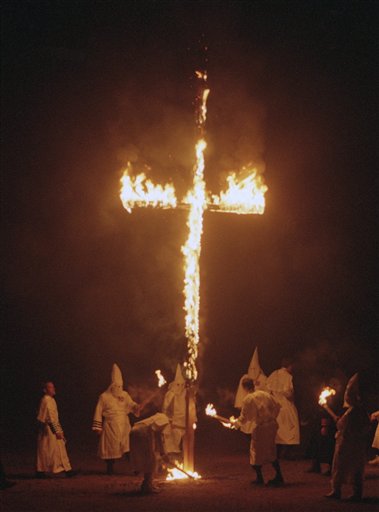By a 6-3 margin, in Virginia v. Black, 538 U.S. 343 (2003), the Supreme Court upheld a Virginia statute making it illegal to burn a cross in public with the intent to intimidate others. It also invalidated a provision of the same law that allowed a jury to infer intent to intimidate from the act of burning a cross in public.
Virginia Supreme Court invalidated statute against cross burning
The case involved two cross burnings — one at a Ku Klux Klan rally and the other in front of an African American’s home. One of the defendants, Klan leader Barry Black, insisted on a trial, after which the judge instructed the jury that the burning of a cross by itself was sufficient to infer the intent to intimidate. Black was then convicted. On appeal, the Supreme Court of Virginia held the statute was unconstitutional.
Supreme Court said cross burning was a ‘true threat’
The Supreme Court reversed. Justice Sandra Day O’Connor’s opinion for the plurality began with a discussion of the history of cross burning. She concluded that some, but not all, cross burnings were intimidatory. Speaking for six justices, she held that even though cross burning was at times expressive, Virginia could ban cross burning because it represented a “true threat.” In her opinion, O’Connor relied on Watts v. United States (1969), which held that true threats are not a form of protected expression under the First Amendment.
“‘True threats’ encompass those statements where the speaker means to communicate a serious expression of an intent to commit an act of unlawful violence to a particular individual or group of individuals,” O’Connor wrote. “Intimidation in the constitutionally proscribable sense of the word is a type of true threat, where a speaker directs a threat to a person or group of persons with the intent of placing the victim in fear of bodily harm or death. Respondents do not contest that some cross burnings fit within this meaning of intimidating speech, and rightly so. As noted … the history of cross burning in this country shows that cross burning is often intimidating, intended to create a pervasive fear in victims that they are a target of violence.”
To distinguish this case from R.A.V. v. St. Paul (1992), which held that a local ordinance that banned cross burnings inspiring hatred based on “race, color, creed, religion or gender” amounted to constitutionally impermissible content discrimination, Justice O’Connor held that cross burning was “a particularly virulent form of discrimination.” Therefore, it fell into an exception established under R.A.V. that let states ban extreme forms of a given type of proscribable speech without banning other, less severe forms.
Court struck down provision allowing jury to infer intent to intimidate
Next, speaking for a majority of seven justices, Justice O’Connor held that the provision allowing the jury to infer intent to intimidate from the public burning of a cross was unconstitutional, because, as a historical matter, not all cross burnings were undertaken with intent to intimidate. Rather, some cross burnings were “a statement of ideology” or “group solidarity.” Moreover, she argued that the defendants who burned the cross on an African American family’s front lawn could have done so out of anger rather than out of an intent to intimidate.
Justice John Paul Stevens concurred in a brief opinion reminding the court that he had dissented in R.A.V.
Dissenting justices thought statute was content discrimination against the Klan
Three justices, led by Justice David H. Souter, took a libertarian position. They agreed with Justice O’Connor that instruction allowing the jury to infer intent to intimidate from the public burning of a cross was unconstitutional, but they would have rejected the entire statute as unconstitutional, largely because they viewed the law as content discrimination directed at the Klan.
Justice Antonin Scalia, in a separate dissent joined by Justice Clarence Thomas, faulted O’Connor for invalidating the jury inference on the basis of a single errant jury charge. Justice Thomas, writing for himself, made the further argument that because cross burning by its very nature is intimidatory, the jury provision raised no constitutional problems.
Not only does Black mark a departure from R.A.V., but its reliance on the Watts “true threats” language suggests a potential retrenchment of the Court’s broad protection of subversive speech, a development that bears watching in an era overshadowed by the War on Terror.
This article was originally published in 2009. Professor Rob Kahn teaches at St. Thomas University School of Law in Minneapolis, Minnesota. His 2004 book Holocaust Denial and the Law: A Comparative Study (Palgrave 2004) dissertation examines Holocaust denial litigation. He has also written on topics such as cross-burning in the United States, blasphemy regulation and the defamation of religions debate, and use of law to ban statements about the past.

